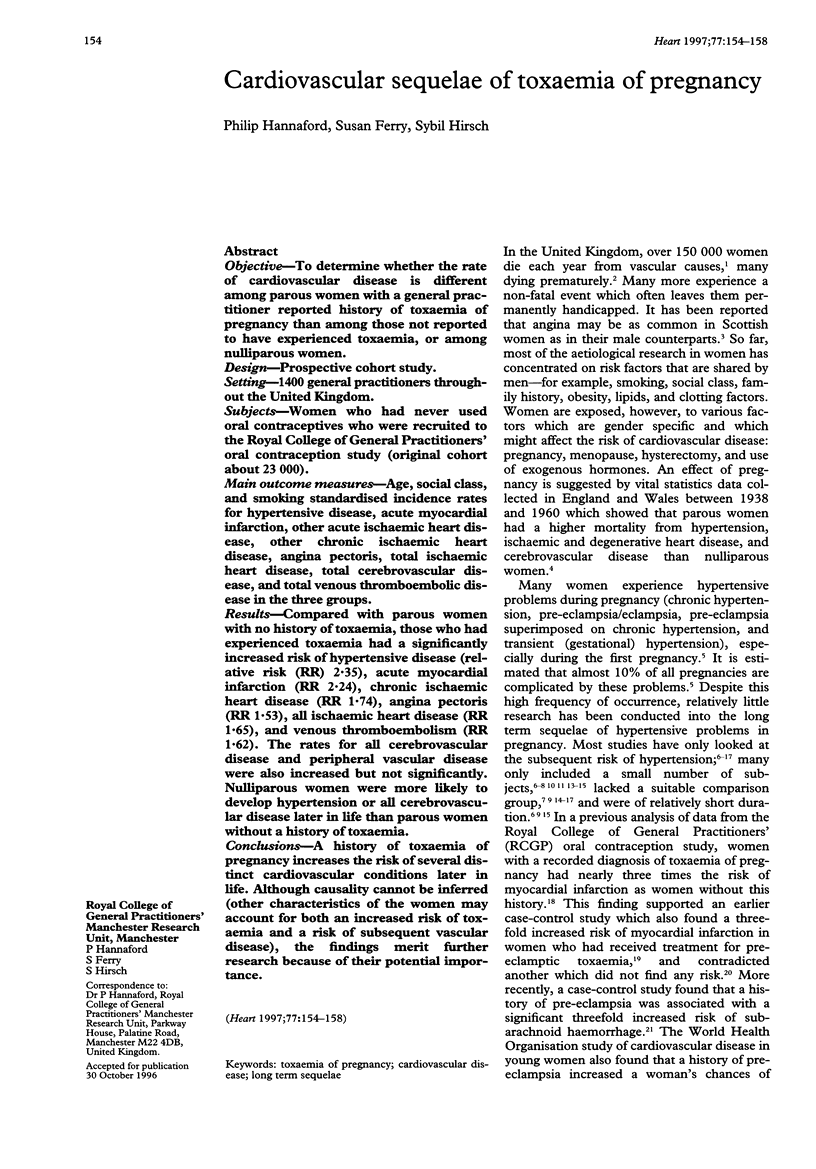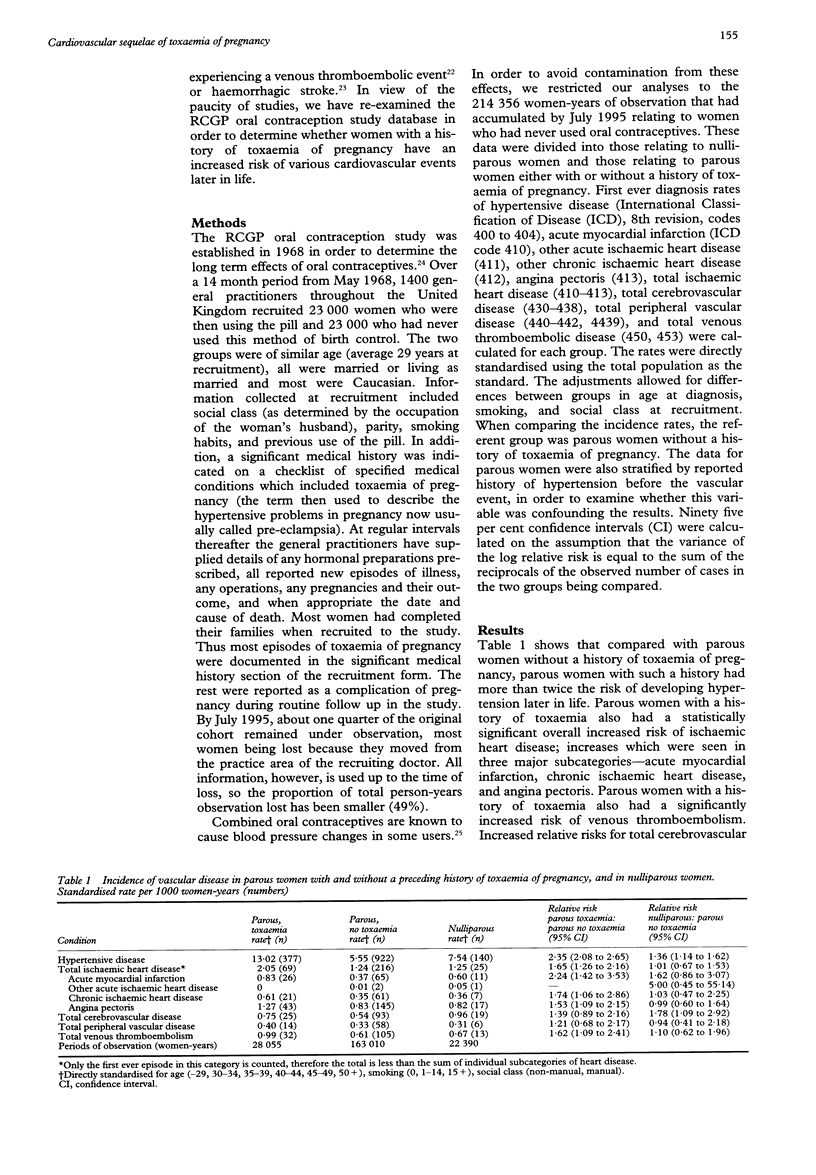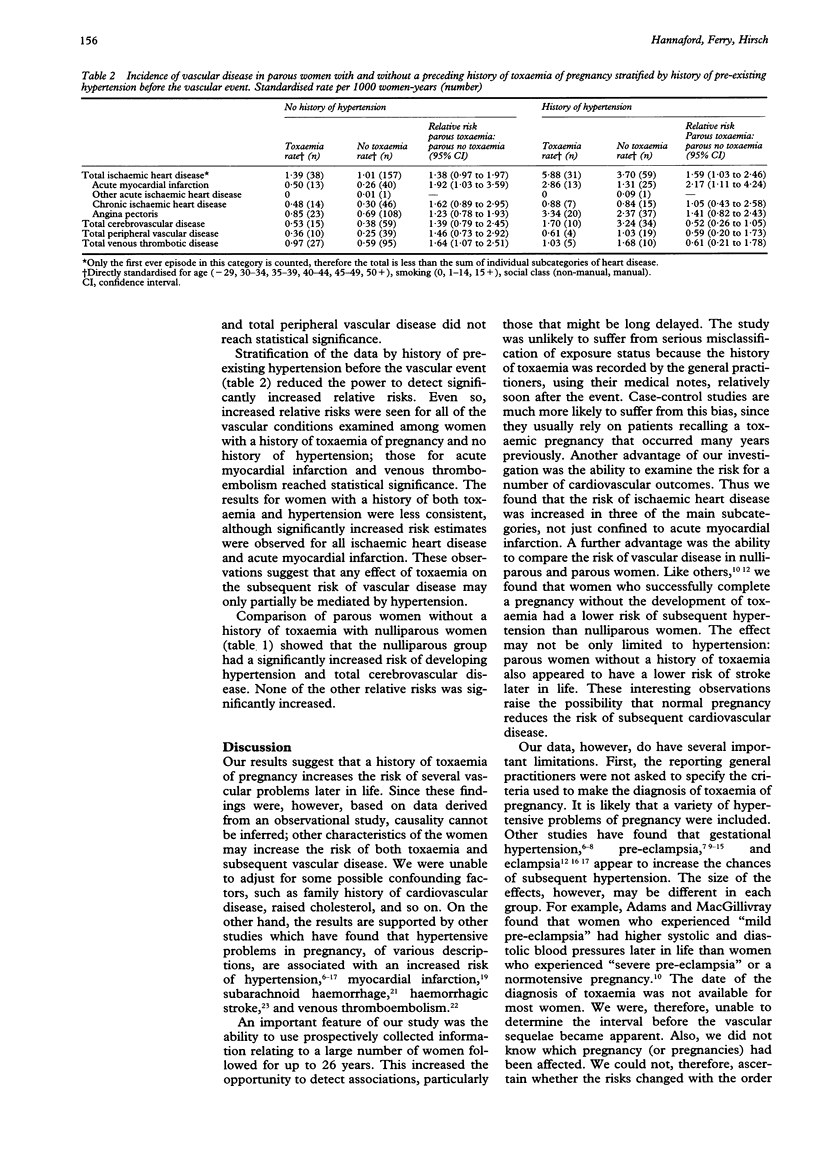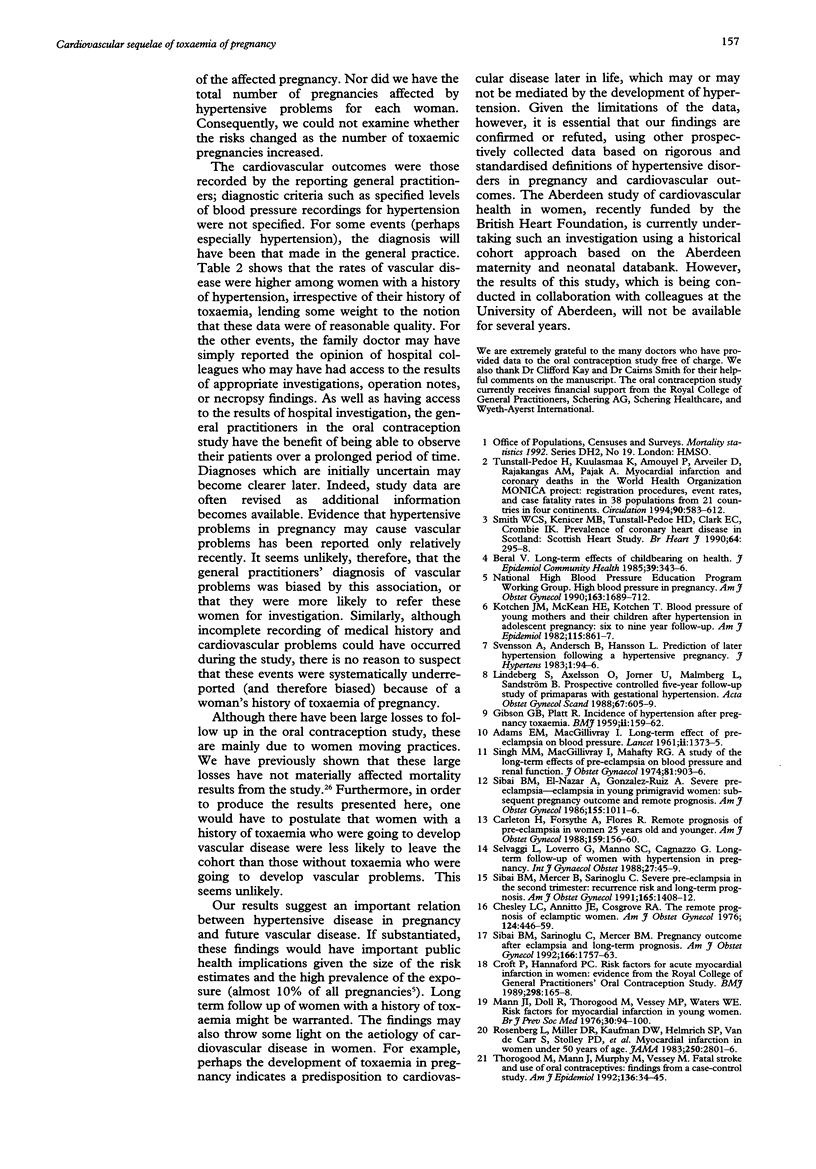Abstract
OBJECTIVE: To determine whether the rate of cardiovascular disease is different among parous women with a general practitioner reported history of toxaemia of pregnancy than among those not reported to have experienced toxaemia, or among nulliparous women. DESIGN: Prospective cohort study. SETTING: 1400 general practitioners throughout the United Kingdom. SUBJECTS: Women who had never used oral contraceptives who were recruited to the Royal College of General Practitioners' oral contraception study (original cohort about 23000). MAIN OUTCOME MEASURES: Age, social class, and smoking standardised incidence rates for hypertensive disease, acute myocardial infarction, other acute ischaemic heart disease, other chronic ischaemic heart disease, angina pectoris, total ischaemic heart disease, total cerebrovascular disease, and total venous thromboembolic disease in the three groups. RESULTS: Compared with parous women with no history of toxaemia, those who had experienced toxaemia had a significantly increased risk of hypertensive disease (relative risk (RR) 2.35), acute myocardial infarction (RR 2.24), chronic ischaemic heart disease (RR 1.74), angina pectoris (RR 1.53), all ischaemic heart disease (RR 1.65), and venous thromboembolism (RR 1.62). The rates for all cerebrovascular disease and peripheral vascular disease were also increased but not significantly. Nulliparous women were more likely to develop hypertension or all cerebrovascular disease later in life than parous women without a history of toxaemia. CONCLUSIONS: A history of toxaemia of pregnancy increases the risk of several distinct cardiovascular conditions later in life. Although causality cannot be inferred (other characteristics of the women may account for both an increased risk of toxaemia and a risk of subsequent vascular disease), the findings merit further research because of their potential importance.
Full text
PDF




Selected References
These references are in PubMed. This may not be the complete list of references from this article.
- ADAMS E. M., MACGILLIVRAY I. Long-term effect of preeclampsia on blood-pressure. Lancet. 1961 Dec 23;2(7217):1373–1375. doi: 10.1016/s0140-6736(61)91196-5. [DOI] [PubMed] [Google Scholar]
- Beral V. Long term effects of childbearing on health. J Epidemiol Community Health. 1985 Dec;39(4):343–346. doi: 10.1136/jech.39.4.343. [DOI] [PMC free article] [PubMed] [Google Scholar]
- Carleton H., Forsythe A., Flores R. Remote prognosis of preeclampsia in women 25 years old and younger. Am J Obstet Gynecol. 1988 Jul;159(1):156–160. doi: 10.1016/0002-9378(88)90513-3. [DOI] [PubMed] [Google Scholar]
- Chesley L. C., Annitto J. E., Cosgrove R. A. The remote prognosis of eclamptic women. Sixth periodic report. Am J Obstet Gynecol. 1976 Mar 1;124(5):446–459. doi: 10.1016/0002-9378(76)90168-x. [DOI] [PubMed] [Google Scholar]
- Chesley L. C., Annitto J. E., Cosgrove R. A. The remote prognosis of eclamptic women. Sixth periodic report. Am J Obstet Gynecol. 1976 Mar 1;124(5):446–459. doi: 10.1016/0002-9378(76)90168-x. [DOI] [PubMed] [Google Scholar]
- Croft P., Hannaford P. C. Risk factors for acute myocardial infarction in women: evidence from the Royal College of General Practitioners' oral contraception study. BMJ. 1989 Jan 21;298(6667):165–168. doi: 10.1136/bmj.298.6667.165. [DOI] [PMC free article] [PubMed] [Google Scholar]
- GIBSON G. B., PLATT R. Incidence of hypertension after pregnancy toxaemia. Br Med J. 1959 Aug 15;2(5145):159–162. doi: 10.1136/bmj.2.5145.159. [DOI] [PMC free article] [PubMed] [Google Scholar]
- Kotchen J. M., McKean H. E., Kotchen T. A. Blood pressure of young mothers and their children after hypertension in adolescent pregnancy: six- to nine-year follow-up. Am J Epidemiol. 1982 Jun;115(6):861–867. doi: 10.1093/oxfordjournals.aje.a113373. [DOI] [PubMed] [Google Scholar]
- Lindeberg S., Axelsson O., Jorner U., Malmberg L., Sandström B. A prospective controlled five-year follow-up study of primiparas with gestational hypertension. Acta Obstet Gynecol Scand. 1988;67(7):605–609. doi: 10.3109/00016348809004272. [DOI] [PubMed] [Google Scholar]
- Mann J. I., Doll R., Thorogood M., Vessey M. P., Waters W. E. Risk factors for myocardial infarction in young women. Br J Prev Soc Med. 1976 Jun;30(2):94–100. doi: 10.1136/jech.30.2.94. [DOI] [PMC free article] [PubMed] [Google Scholar]
- Rosenberg L., Miller D. R., Kaufman D. W., Helmrich S. P., Van de Carr S., Stolley P. D., Shapiro S. Myocardial infarction in women under 50 years of age. JAMA. 1983 Nov 25;250(20):2801–2806. [PubMed] [Google Scholar]
- Selvaggi L., Loverro G., Schena F. P., Manno C., Cagnazzo G. Long term follow-up of women with hypertension in pregnancy. Int J Gynaecol Obstet. 1988 Aug;27(1):45–49. doi: 10.1016/0020-7292(88)90086-0. [DOI] [PubMed] [Google Scholar]
- Sibai B. M., Sarinoglu C., Mercer B. M. Eclampsia. VII. Pregnancy outcome after eclampsia and long-term prognosis. Am J Obstet Gynecol. 1992 Jun;166(6 Pt 1):1757–1763. doi: 10.1016/0002-9378(92)91566-s. [DOI] [PubMed] [Google Scholar]
- Sibai B. M., el-Nazer A., Gonzalez-Ruiz A. Severe preeclampsia-eclampsia in young primigravid women: subsequent pregnancy outcome and remote prognosis. Am J Obstet Gynecol. 1986 Nov;155(5):1011–1016. doi: 10.1016/0002-9378(86)90336-4. [DOI] [PubMed] [Google Scholar]
- Singh M. M., Macgillivray I., Mahaffy R. G. A study of the long-term effects of pre-eclampsia on blood pressue and renal function. J Obstet Gynaecol Br Commonw. 1974 Nov;81(11):903–906. doi: 10.1111/j.1471-0528.1974.tb00404.x. [DOI] [PubMed] [Google Scholar]
- Smith W. C., Kenicer M. B., Tunstall-Pedoe H., Clark E. C., Crombie I. K. Prevalence of coronary heart disease in Scotland: Scottish Heart Health Study. Br Heart J. 1990 Nov;64(5):295–298. doi: 10.1136/hrt.64.5.295. [DOI] [PMC free article] [PubMed] [Google Scholar]
- Svensson A., Andersch B., Hansson L. Prediction of later hypertension following a hypertensive pregnancy. J Hypertens Suppl. 1983 Dec;1(2):94–96. [PubMed] [Google Scholar]
- Thorogood M., Mann J., Murphy M., Vessey M. Fatal stroke and use of oral contraceptives: findings from a case-control study. Am J Epidemiol. 1992 Jul 1;136(1):35–45. doi: 10.1093/oxfordjournals.aje.a116418. [DOI] [PubMed] [Google Scholar]
- Tunstall-Pedoe H., Kuulasmaa K., Amouyel P., Arveiler D., Rajakangas A. M., Pajak A. Myocardial infarction and coronary deaths in the World Health Organization MONICA Project. Registration procedures, event rates, and case-fatality rates in 38 populations from 21 countries in four continents. Circulation. 1994 Jul;90(1):583–612. doi: 10.1161/01.cir.90.1.583. [DOI] [PubMed] [Google Scholar]


